A New Take On The General Purpose Rifle
In Part One of this series, we talked about some of the men who inspired the Scout Rifle. In Part Two, we looked at some of the trends in technology that have guided the concept of a general purpose rifle. Now let’s look at today’s gun culture, and see what a general purpose rifle for today’s gun owner might look like.
Let’s begin by talking about what America’s gun owners look like. Over the years, there has been a shift in who is buying guns in the United States. The people buying guns these days tend to be more urban than ever before. Women and minorities are buying guns in ever-increasing numbers. In short, we are in the midst of a shift in American gun culture. We are moving from Gun Culture 1.0 to Gun Culture 2.0.
Gun Culture 1.0 was all about hunting and the great outdoors. Target shooting, when it happened, was done in the backyard or on public lands. Self-defense was important, but not the #1 reason for owning a gun. This is different for Gun Culture 2.0, which places self-defense at the top of the pyramid, followed by competition, training and target shooting. Hunting is still a thing for Gun Culture 2.0, but it is way down on the lists of reasons to buy a gun.
Given that reality, what would a “do it all,” general-purpose rifle look like for Gun Culture 2.0? First, it would need to be based on the AR platform. The unparalleled modularity of the AR makes it adaptable to almost any situation, and it has become the most-popular rifle in America today. Aside from being a first-rate defensive firearm, AR-patten guns are also used in competition, hunting, and general plinking at the range.
Let’s take a look at some of the starting points we have for a general-purpose rifle for Gun Culture 2.0.
The Scout Rifle
As I said before, I think the scout rifle is a terrific idea, and is perfect of it’s intended uses. However, those uses reflect the priorities of Gun Culture 1.0. When Jeff Cooper first dreamed up the scout rifle, hunting was the main reason why people bought guns. Cooper saw it as a gun that could take just about anything on four (or two) legs. Self-defense was in the mix, but it was meant to be used for one quick, well-aimed shot. Then, the shooter would beat a hasty retreat.
In essence, the scout rifle was meant as a gun for the great outdoors. It is not meant to be used in an urban (or even suburban) setting. In addition to this, competition is a priority for Gun Culture 2.0. IPSC, the first nationwide practical shooting match, was created by Jeff Cooper (yep, the same man who invented the scout rifle) as a way to test what defensive gear worked best in something approaching a “real world” scenario. Unfortunately, there is no real place for the scout rifle in the competitive shooting sports. It doesn’t have the tack-driving accuracy of a precision rifle, and its bolt action and limited capacity make it a poor (very poor) choice for 3 Gun. Let’s look at some other choices.
The AR-15
At first glance, the AR-15 is the perfect “do it all” rifle for Gun Culture 2.0. It’s lightweight, and a very effective self defense gun. It’s the preferred rifle for 3 Gun competitions and also a fairly decent hunting gun. However, it’s that last point, hunting, where things get a little weird for using the AR-15 as a general purpose rifle.
Hunting may not be the #1 priority for today’s gun owners like it is for Gun Culture 2.0. However, it is still a priority, and the .223/5.56mm round fired from most AR-15s just does not have the power to ethically harvest most North American game. Yes, .223 can be used for hogs, and it’s also a great cartridge for coyotes and other predators. However, it is marginal for deer, and anything larger is just not recommended for .223. There is, however, an alternative that provides a lot of advantages of the AR platform, with a larger, more-powerful round.
Enter the AR-10
In his definitive study on the topic, Richard Mann compared the semi-automatic AR-10 to bolt-action scout rifles, and the AR-10 came out quite well. However, the original definition of a scout rifle was a lightweight, general purpose rifle that could be used world-wide. The AR-10, like pretty much all AR-pattern guns, is a semi-automatic rifle, and such guns are restricted for civilian ownership all over the world. An AR-10 just does not make the cut, if you go by the parameters of the original scout rifle.
However, as we said before, those parameters reflect the parameters of Gun Culture 1.0. Not only am I not going to Africa to whack a wildebeest, I have no desire to go there because my right to self-defense is so restricted in that continent. A scout rifle for Gun Culture 2.0, therefore, must take into account that self-defense, competition, defensive training and hunting, in that order, and the AR-10 works well for those activities.
But a scout rifle was meant to be a general purpose rifle that worked well in a variety of situations. It also had a specific set of parameters to meet, which were:
- Lightweight, weighing somewhere between 6.5 and 7.5 pounds.
- Well balanced, with a length around a meter (40 inches) and a barrel length around 19 inches.
- Shoots a powerful cartridge, something that puts out 2400 ft/lbs or more of muzzle energy.
- Should take a sling, and have around 2 MOA accuracy.
- It should have an optics system that allows for fast, close-up shots as well as longer ranged shots, along with backup iron sights if things go wrong.
Taking those parameters into account, along with the priorities of today’s gun owners, I’ve come up with a concept I call “Scout Rifle 2.0”
Building Scout Rifle 2.0
My foundation for this build was an Aero Precision AR-10 lower. I added an Aero Precision upper and a .308 16” Faxon Barrel to the build, along with Rise Armament trigger and a JP Rifles lightweight bolt carrier group. The stock is from Mission First, and the handguard is yet another Aero Precision Product. The muzzle brake is from Sig Sauer, and it allows me to easily attach my suppressor on this rifle. The optics is a Swampfox 1-4 variable power scope in a Warne mount, with Magpul flip up backup sights. Total retail cost for all the components is just over $2000, not including the suppressor.
In total, the rifle weighs 8.5 pounds without the suppressor, which means it is over the weight limit set down by Jeff Cooper all those years ago. However, it does meet every other parameter. It’s under 1 meter in length (without the suppressor). It’s very well-balanced, even with the can on the muzzle. It shoots .308 Winchster, and as we shall see, easily makes the accuracy and muzzle energy requirements. On top of all that, the handguard is festooned with MLOK slots which allow me to add a sling or other accessory.
The variable power optic is one of biggest differences between my rifle and a traditional scout rifle, however, it serves the same purpose. When the scout rifle idea was first created in the 1980’s, the forward-mounted low-power scope was meant to allow for fast shots at close-in targets and long-distance shots as well. Since then, optics have gotten better and better. Low-power variable optics like the Swampfox 1-4x allow for a true 1 power view for close range, yet transition to make accurate shots at longer ranges with a twist of a dial.
Rubber, Meet Road. Road, Rubber
Speaking of accuracy, the original concept for the scout rifle said that it should be capable of 2 MOA groups. That is acceptable accuracy for the field, but keep in mind that Gun Culture 2.0 is quite involved in competition, and that demands a bit more from your gun. In order to test the accuracy of this rifle and see if it would work in competition, as well as deliver the power that we have come to expect in a scout rifle, we’re going to take it to the range and shoot some groups.
The AR-10 is commonly seen in 3 Gun competition, competing in the Heavy Metal division. The caliber/muzzle energy limitations favor the .308 cartridge in that division, and this gun is well set up to compete in that sport. To find out just how well, I shot ten shots of five common .308 rounds through this rifle, measuring their speed with a chronograph set up 10 from the muzzle. I also shot four five round groups with each type of ammo at a distance of 100 yards to get a feel for the accuracy of the gun.
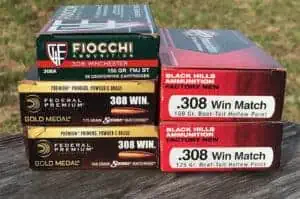 Ammo Test Results
Ammo Test Results
Fiocchi 150 Grain FMJ
Average Group Size: 2.5 inches
Minimum Group Size: 2.18 inches
Maximum Group Size: 3.2 inches
Average Velocity: 2825 fps
Average Muzzle Energy: 2649 ft/lbs
Black Hills 168 Grain Match
Average Group Size: 1.8 inches
Minimum Group Size: 1.59 inches
Maximum Group Size: 2.1 inches
Average Velocity: 2586 fps
Average Muzzle Energy: 2504 ft/lbs
Federal 168 Grain Match
Average Group Size: 1.15 inches
Minimum Group Size: 0.53 inches
Maximum Group Size: 1.65 inches
Average Velocity: 2504 fps
Average Muzzle Energy: 2339 ft/lbs
Black Hills 175 Grain Match
Average Group Size: 1.2 inches
Minimum Group Size: 0.57 inches
Maximum Group Size: 2.19 inches
Average Velocity: 2564 fps
Average Muzzle Energy: 2555 ft/lbs
Federal 175 Grain Match
Average Group Size: 1.48 inches
Minimum Group Size: 1.32 inches
Maximum Group Size: 1.69 inches
Average Velocity: 2495 fps
Average Muzzle Energy: 2417 ft/lbs
Overall Average Group Size: 1.64 inches
Clearly, the Scout Rifle 2.0 meets both the accuracy and muzzle energy requirements for a scout rifle. It does so, in part, because of the quality of the Rise Armaments trigger, which has a great break and an average pull of 2.2 pounds.
The Next Generation of General Purpose Rifle
Is the Scout Rifle 2.0 a successor to the original scout rifle? No. The original scout rifle was created to fulfill a specific role in a specific environment, and it performs that task very, very well. However, the needs of the modern, urban gun owner are quite different than the hunting culture of days gone by. Modern gun owners still need a general purpose rifle. Scout Rifle 2.0 is nothing more than my attempt to build a modern rifle that performs any number of tasks well enough to get by. It is meant to be a jack of all trades rifle that is master of none. Just like its bolt-action predecessor, Scout Rifle 2.0 is meant to be the gun to have if you can have only one.

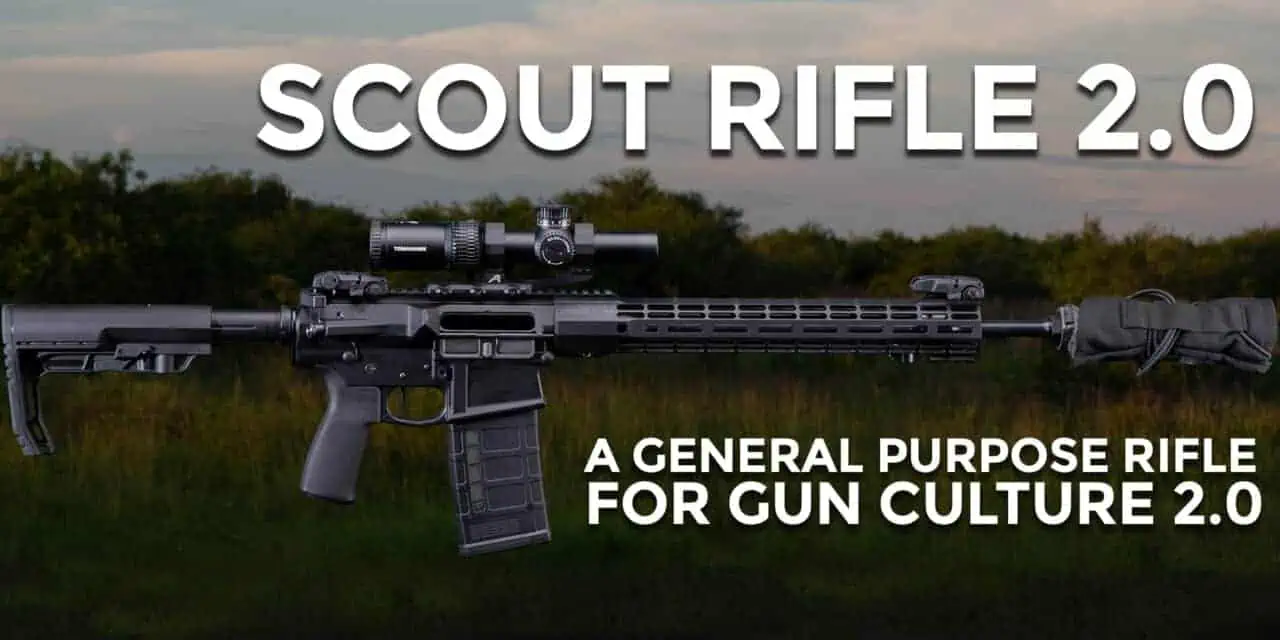
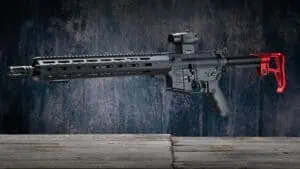
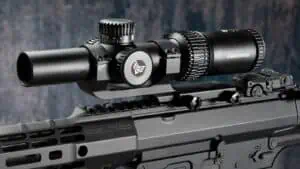
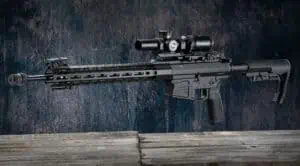

I have a similar setup with an AR-15, and used QD mounts on the scope, in case I need to use the backup sights.
Weight, weight, weight. One can build a lightweight AR10 platforms, for multiple $1000s.
In reality nobody carries AR10s, 99% are 12+lbs and shot from benches and bipods.
So the over riding principle for Scout 2 is? Gaming?